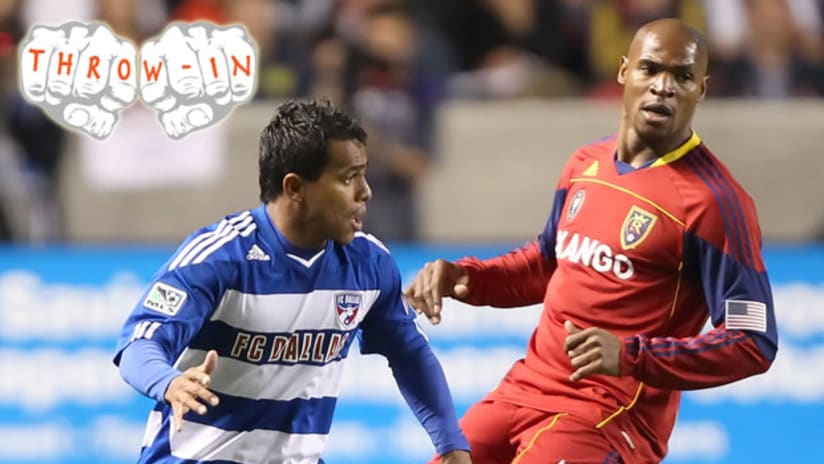Sit back and pour yourself a cup of medium roast, because there’s a revolution going in MLS – and you may not have even noticed.
It’s a bit of a throwback to the beginning of the league, in fact. Only this time, it’s a huge opportunity for MLS’ future.
Over the past four seasons, MLS clubs have been slowly stocking their rosters with Colombians. As of Thursday, 13 Cafeteros were on rosters across the league; a handful of others are trialing with various teams, looking to impress coaches.
It’s a safe bet that most of those 13 – if not all – will make opening-day rosters, and reasonably safe to assume that number will grow before First Kick. Very quietly, that represents the biggest number of Colombians ever in the league at one time (and that's without including Colombian-Americans Juan Agudelo and Francisco Navas Cobo). And that is a very big deal.
[inlinenode:327630]When someone mentions Colombians in MLS, you’ll likely no doubt picture images of Juan Pablo Angel and Fredy Montero burying the ball in the back of the net.
Maybe you think of reigning MVP David Ferreira carving up defenses like Swiss cheese. Or maybe you’re envisioning Jamison Olave or Jhon Kennedy Hurtado applying bone-crunching tackles on a hapless would-be attacker.
Why is that remarkable? Because even as recently as five years ago, the idea of Colombians in MLS prompted a trip down memory lane. You’d likely think of swashbuckling Carlos Valderrama, smash-and-grab artist Leonel Álvarez and perhaps midfield quarterback Óscar Pareja – in most cases, guys who hung up their cleats a decade ago.
And that’s all fine and good. MLS spent a pretty penny to bring in some eye-catching Colombian talent in the early years, which netted players with World Cup and Copa América experience. The Colombian national team was highly touted leading into the 1994 World Cup, and many of those players were recognizable to the American audience.
More Colombians came right behind them after seeing their countrymen have some success, guys like Diego Cerna, Carlos Llamosa, John Wilmar Pérez and Johnny Torres. In fact, by 2000 and ’01, the league enjoyed a dozen Colombians running around MLS pitches.
But those guys are long gone. In fact, Colombians all but disappeared from the league as recently as five years ago as Colombian soccer hit one of the lowest points in its history.
That all changed in 2007, the earliest days of the New Colombian Revolution. For one, Ángel arrived as a Designated Player from Aston Villa. But ironically, he wasn’t the catalyst. In fact, JPA more matched the profile of the earlier guys: a proven star who hacked it in Europe and came into MLS with a pedigree.
It was the unknown quantities who followed around the same time that marked the beginning of the trend: Juan Toja and Wilman Conde in ’07 and Olave a year later – and then the floodgates opened. Skilled, effective Colombians have come in and almost immediately seized regular spots all over the league.
“Our players can do a little of everything,” says Colombian-born former US international Llamosa, who still associates more with his homeland from a sporting point of view. “Our defenders are strong and fast, and their physical skills match this league. Our playmakers and forwards are very technical and smart with ball – they know how to best use one or two touches.”
[inlinenode:305418]What’s changed? Colombia’s loss has been MLS’ gain.
“The state of Colombian soccer is not the best right now,” explains MLS original Diego Gutiérrez, one of six Colombians who were part of the league’s inaugural season. “A lot of clubs have gone belly up and their finances are in disarray. The only way to balance books is to sell their assets.”
Indeed, even though the Colombian economy is holding strong, the nation’s soccer has been hit hard. And that's due in large part to the crackdown on Colombia’s drug cartels, many of whom once held enormous influence over the power clubs like América de Cali, Atlético Nacional and Millonarios.
And that’s where MLS has been given a golden opportunity to strike. Gutiérrez, in his new role as head of scouting and player development for the Philadelphia Union, helped hand-deliver the signatures of countrymen Faryd Mondragón and Carlos Valdés to the club. Those are just two of the new Colombian faces entering the league this year, and Gutiérrez says the cat is out of the bag with all 18 MLS clubs.
“Now, it’s more the case that the Colombian player within Latin America offers a unique package and value,” he says. “They can adapt and accommodate to any culture – a lot are bilingual, a lot have played in other leagues in South America and Mexico. Yet their value in the market is inexpensive, and they fit [MLS] well.”
This is why, for instance, MLS clubs were able to swoop in for former Deportivo Cali players like Montero, Olave, Hurtado and Jair Benitez. It’s why Conde was available from floundering Millonarios. It’s also why the Union were able to scoop up flowering young talents like Valdés and Roger Torres from teams who were desperate to get out of the red.
MLS is the better for it. Those players represent the best of what Colombian soccer has to offer: tactically sound players who still boast some of that South American flair. But more importantly, they’re smart, adaptable guys who take little time to get accustomed to the pace and physicality of MLS. They help raise the level of play in the league, and provide some pretty dandy fireworks to boot.
“In Colombia, they see this as an important league,” says Llamosa, now an assistant coach at Chivas USA. “Players see the level of success of guys like Olave, Ferreira and Benítez, and they think, ‘I can make it there, too.’”
The revolution continues.
Jonah Freedman is the managing editor of MLSsoccer.com. “The Throw-In” appears every Thursday.


